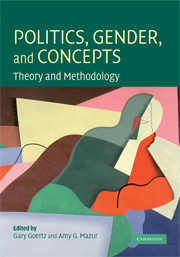Book contents
- Frontmatter
- Contents
- List of figures
- List of tables
- Notes on contributors
- Acknowledgments
- 1 Introduction
- 2 Mapping gender and politics concepts: ten guidelines
- Part I Gendering Concepts
- Part II Gender-Specific Concepts
- 8 Gender ideology: masculinism and feminalism
- 9 Intersectionality
- 10 Women's movements, feminism, and feminist movements
- 11 State feminism
- Appendix: A website for additional gender and politics concepts
- References
- Index
10 - Women's movements, feminism, and feminist movements
Published online by Cambridge University Press: 06 July 2010
- Frontmatter
- Contents
- List of figures
- List of tables
- Notes on contributors
- Acknowledgments
- 1 Introduction
- 2 Mapping gender and politics concepts: ten guidelines
- Part I Gendering Concepts
- Part II Gender-Specific Concepts
- 8 Gender ideology: masculinism and feminalism
- 9 Intersectionality
- 10 Women's movements, feminism, and feminist movements
- 11 State feminism
- Appendix: A website for additional gender and politics concepts
- References
- Index
Summary
“Women's movement” is a term widely used by journalists, activists, politicians, scholars, and citizens alike; most people have a general idea of the concept's meaning. Despite the widespread attention to the term since the 1970s, social science is in the early stages of conceptualization (Beckwith 2005a). A quick glance at scholarly work on women's movements indicates there is agreement on neither a general definition nor how the concept should be used in empirical research. In fact, researchers seldom give an explicit definition of the term. Can we be sure that women's movement scholars are talking about the same thing? If not, studies and theories of women's movements risk being inaccurate and perhaps even unintentionally misleading. Our own research on women's movements and women's policy agencies reveals a debate among scholars that has left unanswered many questions about how to use women's movements as a concept for good research. The more notable ones include:
How can movement characteristics be measured?
How can movement impact be measured?
What distinguishes women participants in government and politics from the movement?
Can men be in women's movements?
Is “women's movement” a singular or collective noun, or are there many movements?
Are women's movements defined by their mobilization of women exclusively, or by their goals, or both? For example, are women's peace movements women's movements?
The absence of a consensus about the conceptual use of “women's movement” is quite similar for the related concept “feminist movement/feminism,” but with a controversial twist.
- Type
- Chapter
- Information
- Politics, Gender, and ConceptsTheory and Methodology, pp. 219 - 243Publisher: Cambridge University PressPrint publication year: 2008
- 25
- Cited by



